Silicas with Polyoxyethylene Branches for Modification of Membranes Based on Microporous Block Copolymers
Abstract
1. Introduction
2. Materials and Methods
2.1. Materials
2.2. Synthesis of ASiP-Cu
2.3. Synthesis of PEG-Cu
2.4. Synthesis of OBC
2.5. Preparation of Samples
2.6. Measurements
2.6.1. Fourier Transform Infrared (FT-IR) Spectroscopy Analysis
2.6.2. Thermal Gravimetric Analysis (TGA)
2.6.3. Ultraviolet Visible (UV–Vis) Spectroscopy
2.6.4. Dynamic Light Scattering (DLS)
2.6.5. Measurements of the Surface Tension
2.6.6. Water Absorption Tests
2.6.7. Dynamic Viscosity and Density Measurements
2.6.8. NMR Spectroscopy
2.6.9. Water Concentration Measurement
2.6.10. Mechanical Loss Tangent Measurements (MLT)
2.6.11. Thermomechanical Analysis (TMA)
2.6.12. Contact Angle Measurements
2.6.13. AFM Studies
3. Results
3.1. Silicas with Polyoxyethylene Branches Characterization
3.2. Polymer Sorption Capacity
4. Conclusions
Author Contributions
Funding
Institutional Review Board Statement
Data Availability Statement
Acknowledgments
Conflicts of Interest
References
- Eisenman, G.; Sandblom, J.P.; Walker, J.L. Membrane Structure and Ion Permeation. Science 1967, 155, 965–974. [Google Scholar] [CrossRef] [PubMed]
- Moody, G.J.; Oke, R.B.; Thomas, J.D.R. A calcium-sensitive electrode based on a liquid ion exchanger in a poly(vinyl chloride) matrix. Analyst 1970, 95, 910–918. [Google Scholar] [CrossRef]
- Vilela, C.; Morais, J.D.; Silva, A.C.Q.; Muñoz-Gil, D.; Figueiredo, F.M.L.; Silvestre, A.J.D.; Freire, C.S.R. Flexible Nanocellulose/Lignosulfonates Ion-Conducting Separators for Polymer Electrolyte Fuel Cells. Nanomaterials 2020, 10, 1713. [Google Scholar] [CrossRef] [PubMed]
- Hisamoto, H.; Suzuki, K. Ion-selective optodes: Current developments and future prospects. TrAC Trends Anal. Chem. 1999, 18, 513–524. [Google Scholar] [CrossRef]
- Aksuner, N.; Henden, E.; Yilmaz, I.; Cukurovali, A. A highly sensitive and selective fluorescent sensor for the determination of copper(II) based on a schiff base. Dyes Pigment. 2009, 83, 211–217. [Google Scholar] [CrossRef]
- Denna, M.C.F.J.; Camitan, R.A.B.; Yabut, D.A.O.; Rivera, B.A.; Coo, L.D. Determination of Cu(II) in environmental water samples using polymer inclusion membrane-TAC optode in a continuous flow system. Sens. Actuators B Chem. 2018, 260, 445–451. [Google Scholar] [CrossRef]
- A Zolotov, Y.; I Tsysin, G.; I Morosanova, E.; Dmitrienko, S.G. Sorption preconcentration of microcomponents for chemical analysis. Russ. Chem. Rev. 2005, 74, 37–60. [Google Scholar] [CrossRef]
- Dmitrienko, S.G.; Tikhomirova, T.I.; Apyari, V.V.; Tolmacheva, V.V.; Kochuk, E.V.; Zolotov, Y.A. Application of Hyper-crosslinked Polystyrenes to the Preconcentration and Separation of Organic Compounds and Ions of Elements. J. Anal. Chem. 2018, 73, 1053–1063. [Google Scholar] [CrossRef]
- Ghemati, D.; Aliouche, D. Dye Adsorption Behavior of Polyvinyl Alcohol/Glutaraldehyde/β-Cyclodextrin Polymer Membranes. J. Appl. Spectrosc. 2014, 81, 257–263. [Google Scholar] [CrossRef]
- Filho, N.D.; Gushikem, Y.; Franco, D.; Schultz, M.; Vasconcellos, L. Study of copper complexes adsorbed on a silica gel surface chemically modified with 2-amino-1,3,4-thiadiazole. Colloids Surf. A Physicochem. Eng. Asp. 1998, 141, 181–187. [Google Scholar] [CrossRef]
- Giokas, D.L.; Paleologos, E.K.; Prodromidis, M.I.; Karayannis, M.I. Development of 1-(2-pyridylazo)-2-naphthol-modified polymeric membranes for the effective batch pre-concentration and determination of zinc traces with flame atomic absorption spectrometry. Talanta 2002, 56, 491–498. [Google Scholar] [CrossRef]
- Olsén, P.; Odelius, K.; Keul, H.; Albertsson, A.-C. Macromolecular Design via an Organocatalytic, Monomer-Specific and Temperature-Dependent “On/Off Switch”. High Precision Synthesis of Polyester/Polycarbonate Multiblock Copolymers. Macromolecules 2015, 48, 1703–1710. [Google Scholar] [CrossRef]
- Pourbasheer, E.; Morsali, S.; Banaei, A.; Aghabalazadeh, S.; Ganjali, M.R.; Norouzi, P. Design of a novel optical sensor for determination of trace amounts of copper by UV/vis spectrophotometry in the real samples. J. Ind. Eng. Chem. 2015, 26, 370–374. [Google Scholar] [CrossRef]
- Rouis, A.; Echabaane, M.; Sakly, N.; Bonnamour, I.; BEN Ouada, H. Characterization of a sensitive and selective copper optode based on β-ketoimine modified calix[4]arene derivative. Mater. Sci. Eng. C 2015, 46, 125–131. [Google Scholar] [CrossRef] [PubMed]
- Soborover, E.I.; Tverskoi, V.A.; Tokarev, S.V. An optical chemical sensor based on functional polymer films for controlling sulfur dioxide in the air of the working area: Acrylonitrile and alkyl methacrylate copolymers with brilliant green styrene sulfonate. J. Anal. Chem. 2005, 60, 274–281. [Google Scholar] [CrossRef]
- Dedkova, V.P.; Shvoeva, O.P.; Savvin, S.B. Sorption-spectrometric determination of lanthanum in the presence of uranium and thorium with the reagent arsenazo m on the solid phase of fibrous filled sorbents. J. Anal. Chem. 2007, 62, 733–737. [Google Scholar] [CrossRef]
- Diaz, R.H.; Ferguson, A.P. Block Copolymers: Phase Morphology, Material Applications and Future Challenges. Block Co-Polymers: Phase Morphology, Material Applications and Future Challenges; Nova Science Publishers: New York, NY, USA, 2014; p. 1. [Google Scholar]
- Beyer, V.P.; Kim, J.; Becer, C.R. Synthetic approaches for multiblock copolymers. Polym. Chem. 2020, 11, 1271–1291. [Google Scholar] [CrossRef]
- Thomas, C.S.; Elizalde, L.E.; Regalado, E.J.; De Jesús-Téllez, M.A.; Festag, G.; Schubert, U.S.; Guerrero-Sánchez, C. Understanding the influence of chemical structure and length of hydrophobic blocks on the rheological properties of associative copolymers. Eur. Polym. J. 2020, 143, 110190. [Google Scholar] [CrossRef]
- Wong, C.K.; Qiang, X.; Muller, A.H.E.; Groschel, A.H. Self-assembly of block copolymers into internally ordered microparticles. Prog. Polym. Sci. 2020, 102, 101211. [Google Scholar] [CrossRef]
- Yuan, W.; Yuan, J.; Zhang, F.; Xie, X.; Pan, C. Synthesis, Characterization, crystalline morphologies, and hydrophilicity of brush copolymers with double crystallizable side chains. Macromolecules 2007, 40, 9094–9102. [Google Scholar] [CrossRef]
- Varlas, S.; Lawrenson, S.B.; Arkinstall, L.A.; O’reilly, R.K.; Foster, J.C. Self-assembled nanostructures from amphiphilic block copolymers prepared via ring-opening metathesis polymerization (ROMP). Prog. Polym. Sci. 2020, 107, 101278. [Google Scholar] [CrossRef]
- Schacher, F.H.; Rupar, P.A.; Manners, I. Functional block copolymers: Nanostructured materials with emerging applications angew. Chem. Int. Ed. 2012, 51, 7898–7921. [Google Scholar] [CrossRef]
- Listak, J.; Jakubowski, W.; Mueller, L.; Plichta, A.; Matyjaszewski, K.; Bockstaller, M.R. Effect of symmetry of molecular weight distribution in block copolymers on formation of “meta-stable” morphologies. Macromolecules 2008, 41, 5919–5927. [Google Scholar] [CrossRef]
- Nunes, S.P.; Sougrat, R.; Hooghan, B.; Anjum, D.H.; Behzad, A.R.; Zhao, L.; Pradeep, N.; Pinnau, I.; Vainio, U.; Peinemann, K.-V. Ultraporous Films with Uniform Nanochannels by Block Copolymer Micelles Assembly. Macromolecules 2010, 43, 8079–8085. [Google Scholar] [CrossRef]
- Höhme, C.; Hahn, J.; Lademann, B.; Meyer, A.; Bajer, B.; Abetz, C.; Filiz, V.; Abetz, V. Formation of high thermally stable isoporous integral asymmetric block copolymer membranes. Eur. Polym. J. 2016, 85, 72–81. [Google Scholar] [CrossRef]
- Davletbaeva, I.M.; Mazil’nikov, A.I.; Zaripov, I.I.; Davletbaev, R.S.; Gumerov, A.M.; Parfenov, V.V. Synthesis of Block Co-polymers Based on a Macroinitiator and 2,4-Toluene Diisocyanate. Polym. Sci. Ser. B 2018, 60, 34–40. [Google Scholar] [CrossRef]
- Davletbaeva, I.M.; Zaripov, I.I.; Mazilnikov, A.I.; Davletbaev, R.S.; Sharifullin, R.R.; Atlaskin, A.A.; Sazanova, T.S.; Vorotyntsev, I.V. Synthesis and Study of Gas Transport Properties of Polymers Based on Macroinitiators and 2,4-Toluene Diisocyanate. Membranes 2019, 9, 42. [Google Scholar] [CrossRef]
- Davletbaeva, I.M.; Alentiev, A.Y.; Faizulina, Z.Z.; Zaripov, I.I.; Nikiforov, R.Y.; Parfenov, V.V.; Arkhipov, A.V. Organosili-ca-Modified Multiblock Copolymers for Membrane Gas Separation. Polymers 2021, 13, 3579. [Google Scholar] [CrossRef] [PubMed]
- Davletbaev, R.S.; Zaripov, I.I.; Faizulina, Z.Z.; Davletbaeva, I.M.; Domrachova, D.S.; Gumerov, A.M. Synthesis and charac-terization of amphiphilic branched silica derivatives associated with oligomeric medium. RSC Adv. 2019, 9, 21233–21242. [Google Scholar] [CrossRef]
- Shin, Y.; Lee, D.; Lee, K.; Ahn, K.H.; Kim, B. Surface properties of silica nanoparticles modified with polymers for polymer nanocomposite applications. J. Ind. Eng. Chem. 2008, 14, 515–519. [Google Scholar] [CrossRef]
- Parida, S.K.; Dash, S.; Patel, S.; Mishra, B. Adsorption of organic molecules on silica surface. Adv. Colloid Interface Sci. 2006, 121, 77–110. [Google Scholar] [CrossRef]
- Mubarekyan, E.; Santore, M.M. Influence of Molecular Weight and Layer Age on Self-Exchange Kinetics for Saturated Layers of PEO in a Good Solvent. Macromolecules 2001, 34, 4978–4986. [Google Scholar] [CrossRef]
- Al Akoum, R.; Vaulot, C.; Schwartz, D.; Hirn, M.-P.; Haidar, B. How silanization of silica particles affects the adsorption of PDMS chains on its surface. J. Polym. Sci. Part B Polym. Phys. 2010, 48, 2371–2378. [Google Scholar] [CrossRef]
- García, N.; Benito, E.; Tiemblo, P.; Hasan, M.M.B.; Synytska, A.; Stamm, M. Chemically guided topography in alkylsilane- and oligosiloxane-modified silica nanoparticle coatings: From very hydrophobic surfaces to “pearl” bouncing droplets. Soft Matter 2010, 6, 4768–4776. [Google Scholar] [CrossRef]
- Silviana, S.; Sanyoto, J.G.; Darmawan, A. Preparation of geothermal silica glass coating film through multi-factor optimization. J. Teknol. 2021, 83, 41–49. [Google Scholar] [CrossRef]
- Kyriakou, N.; Pizzoccaro-Zilamy, M.-A.; Nijmeijer, A.; Luiten-Olieman, M.; Winnubst, L. Hydrolytic stability of PEG-grafted γ-alumina membranes: Alkoxysilane vs phosphonic acid linking groups. Microporous Mesoporous Mater. 2020, 307, 110516. [Google Scholar] [CrossRef]
- Papra, A.; Gadegaard, N.; Larsen, N.B. Characterization of Ultrathin Poly(ethylene glycol) Monolayers on Silicon Substrates. Langmuir 2001, 17, 1457–1460. [Google Scholar] [CrossRef]
- Akbari, A.; Yegani, R.; Pourabbas, B. Synthesis of poly(ethylene glycol) (PEG) grafted silica nanoparticles with a minimum adhesion of proteins via one-pot one-step method. Colloids Surf. A Physicochem. Eng. Asp. 2015, 484, 206–215. [Google Scholar] [CrossRef]
- Popova, M.; Koseva, N.; Trendafilova, I.; Lazarova, H. Mitova Design of PEG-modified magnetic nanoporous silica based miltefosine delivery system: Experimental and theoretical approaches. Microporous Mesoporous Mater 2021, 310, 110664. [Google Scholar] [CrossRef]
- Al-shaeli, M.; Smith, S.J.D.; Jiang, S.; Wang, H.; Zhang, K.; Ladewig, B.P. Anti-fouling performance of mixed matrix PVDF membranes with mono-hydroxyl poly(dimethylsiloxane) (PDMS-OH) grafted silica nanoparticles. ChemRxiv 2020, 1–9. [Google Scholar] [CrossRef]
- Sulym, I.; Borysenko, M.; Goncharuk, O.; Terpilowski, K.; Sternik, D.; Chibowski, E.; Gun’ko, V. Structural and hydrophobic–hydrophilic properties of nanosilica/zirconia alone and with adsorbed PDMS. Appl. Surf. Sci. 2011, 258, 270–277. [Google Scholar] [CrossRef]
- Bandyopadhyay, A.; De Sarkar, M.; Bhowmick, A.K. Epoxidized Natural Rubber/Silica Nanoscale Organic-Inorganic Hybrid Composites Prepared by Sol-Gel Technique. Rubber Chem. Technol. 2004, 77, 830–846. [Google Scholar] [CrossRef]
- Mark, J.E. Ceramic-reinforced polymers and polymer-modified ceramics. Polym. Eng. Sci. 1996, 36, 2905–2920. [Google Scholar] [CrossRef]
- Erdodi, G.; Kennedy, J.P. Amphiphilic conetworks: Definition, synthesis, applications. Prog. Polym. Sci. 2006, 31, 1–18. [Google Scholar] [CrossRef]
- Koenigs, M.M.E.; Pal, A.; Mortazavi, H.; Pawar, G.M.; Storm, C.; Sijbesma, R.P. Tuning cross-link density in a physical hy-drogel by supramolecular self-sorting. Macromolecules 2014, 47, 2712–2717. [Google Scholar] [CrossRef]
- Xia, L.-W.; Xie, R.; Ju, X.-J.; Wang, W.; Chen, Q.; Chu, L.-Y. Nano-structured smart hydrogels with rapid response and high elasticity. Nat. Commun. 2013, 4, 2226. [Google Scholar] [CrossRef]
- Liu, J.; Qu, S.; Suo, Z.; Yang, W. Functional hydrogel coatings. Natl. Sci. Rev. 2020, 8, nwaa254. [Google Scholar] [CrossRef] [PubMed]
- Pampararo, G.; Garbarino, G.; Riani, P.; Vykoukal, V.; Busca, G.; Debecker, D.P. Ethanol dehydrogenation to acetaldehyde with mesoporous Cu-SiO2 catalysts prepared by aerosol-assisted sol–gel. Chem. Eng. J. 2023, 465, 142715. [Google Scholar] [CrossRef]
- Brinker, C.J.; Scherer, G.E. Sol-Gel Science: The Physics and Chemistry of Sol-Gel Processing; Academic Press Inc.: San Diego, CA, USA, 1990. [Google Scholar]
- Estella, J.; Echeverría, J.C.; Laguna, M.; Garrido, J.J. Effects of aging and drying conditions on the structural and textural properties of silica gels. Microporous Mesoporous Mater. 2007, 102, 274–282. [Google Scholar] [CrossRef]
- Topuz, B.; Çiftçioğlu, M. Preparation of particulate/polymeric sol-gel derived microporous silica membranes and determination of their gas permeation properties. J. Membr. Sci. 2010, 350, 42–52. [Google Scholar] [CrossRef]
- Fardad, M.A. Catalysts and the structure of SiO2 sol-gel films. J. Mater. Sci. 2000, 35, 1835–1841. [Google Scholar] [CrossRef]
- McDonagh, C.; Sheridan, F.; Butler, T.; MacCraith, B. Characterisation of sol-gel-derived silica films. J. Non-Cryst. Solids 1996, 194, 72–77. [Google Scholar] [CrossRef]
- Butler, T.; MacCraith, B.; McDonagh, C. Leaching in sol–gel-derived silica films for optical pH sensing. J. Non-Cryst. Solids 1998, 224, 249–258. [Google Scholar] [CrossRef]
- Musgo, J.; Echeverría, J.C.; Estella, J.; Laguna, M.; Garrido, J.J. Ammonia-catalyzed silica xerogels: Simultaneous effects of pH, synthesis temperature, and ethanol: TEOS and water: TEOS molar ratios on texturaland structural properties. Microporous Mesoporous Mater. 2009, 118, 280–287. [Google Scholar] [CrossRef]
- Abe, Y.; Gunji, T. Oligo- and polysiloxanes. Prog. Polym. Sci. 2004, 29, 149–182. [Google Scholar] [CrossRef]
- Abe, Y.; Shimao, R.; Arimitsu, K.; Gunj, T. Preparation and Properties of High Molecular Weight Polyethoxysiloxanes Stable to Self-Condensation by Acid Catalyzed Hydrolytic Polycondensation of Tetraethoxysilan. J. Polym. Sci. Part A: Polym. Chem. 2003, 41, 2250–2255. [Google Scholar] [CrossRef]
- Lever, A.B.P. Inorganic Electronic Spectroscopy. Physical Inorganic Chemistry, Monograph, 1st ed.; Elsevier: Amsterdam, The Netherlands, 1984. [Google Scholar]
- Vögtle, F.; Weber, E. Host Guest Complex Chemistry. Macrocycles, Synthesis, Structures, Applications; Springer: Berlin/Heidelberg, Germany; New York, NY, USA; Tokyo, Japan, 1985; p. 421. [Google Scholar]
- Field, L.; Sternhell, S.; Kalman, J. Organic Structures from Spectra, 4th ed.; John Wiley & Sons Ltd.: Hoboken, NJ, USA, 2008; p. 453. [Google Scholar]
- Berger, S.; Braun, S. 200 and More NMR Experiments; Wiley-VCH: Weihheim, Germany, 2004; p. 854. [Google Scholar]
- Bellamy, L. The Infrared Spectra of Complex Molecules; Wiley: New York, NY, USA, 1964; p. 425. [Google Scholar]
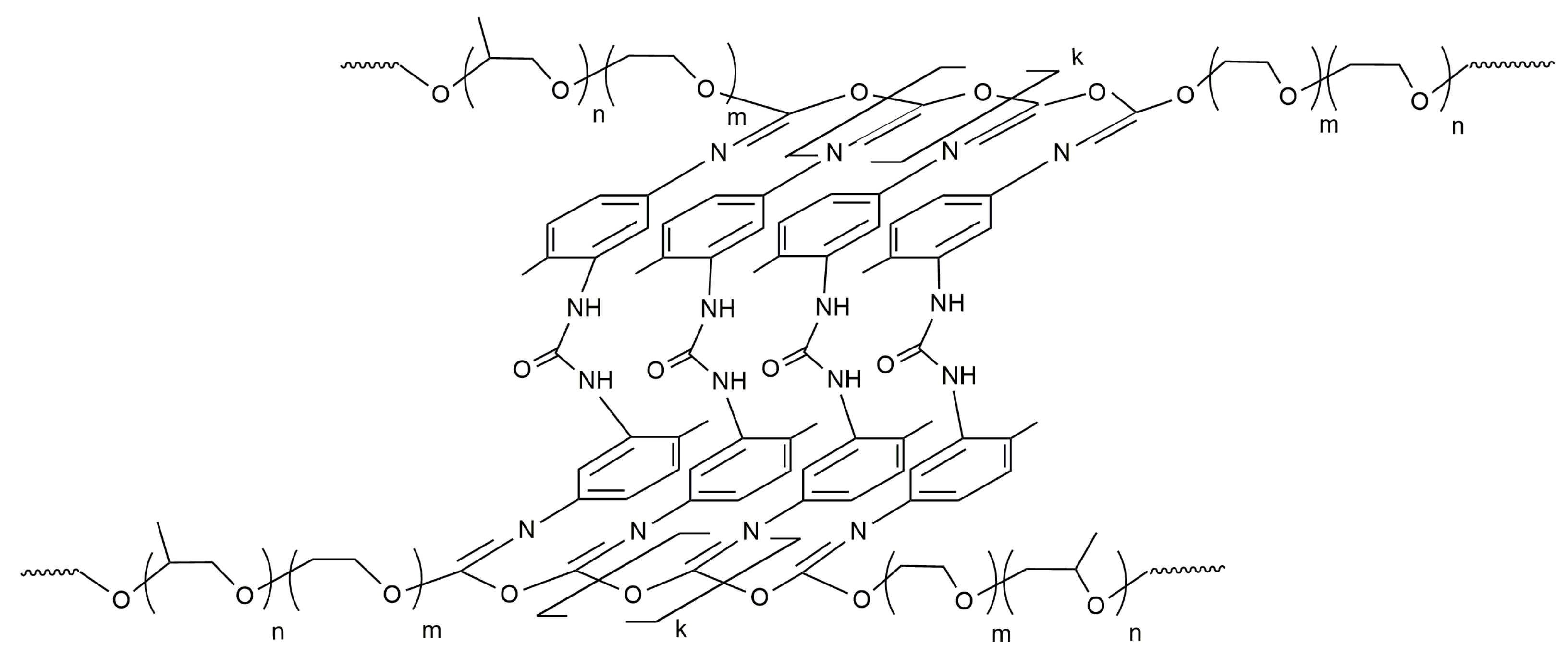
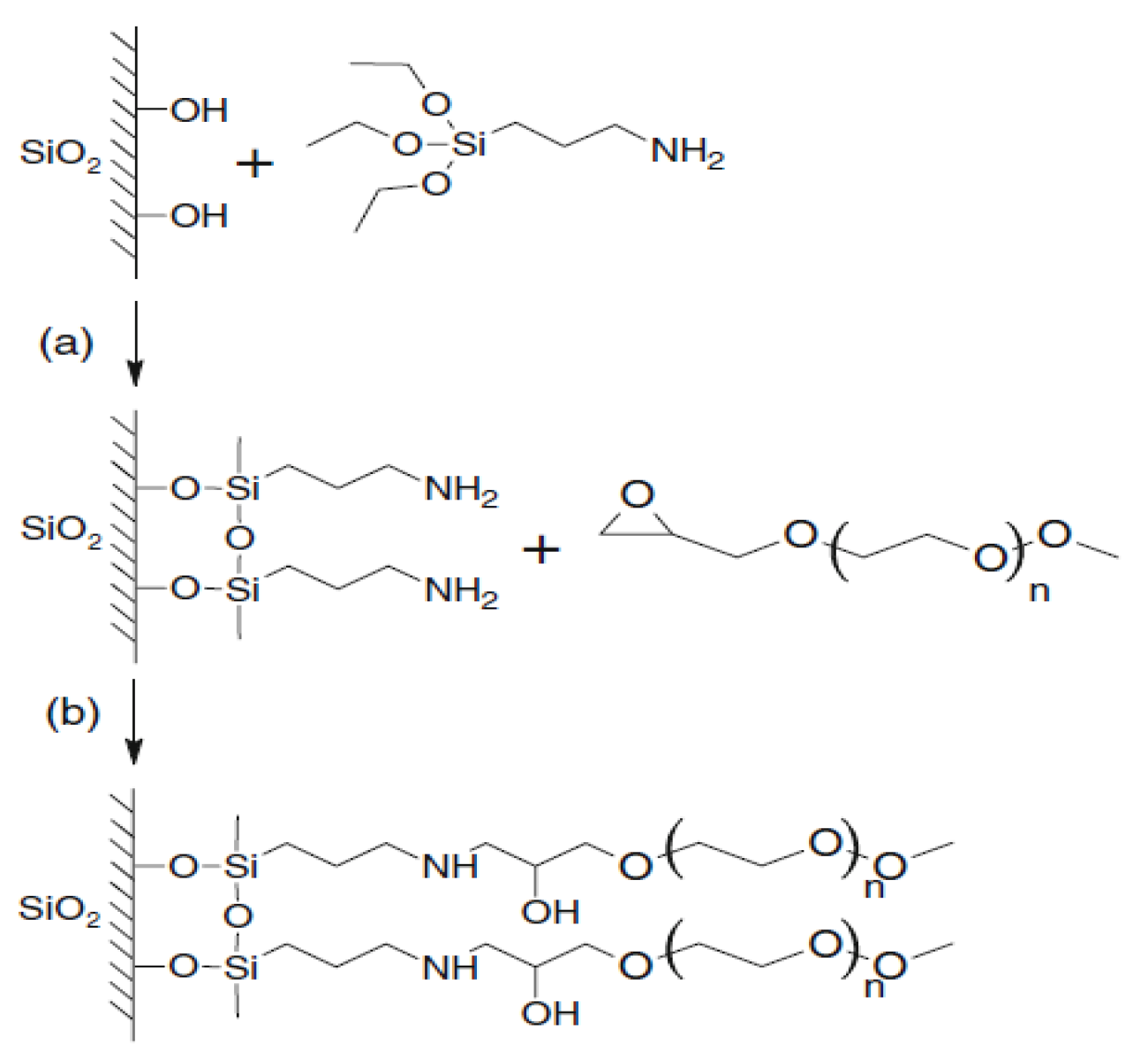

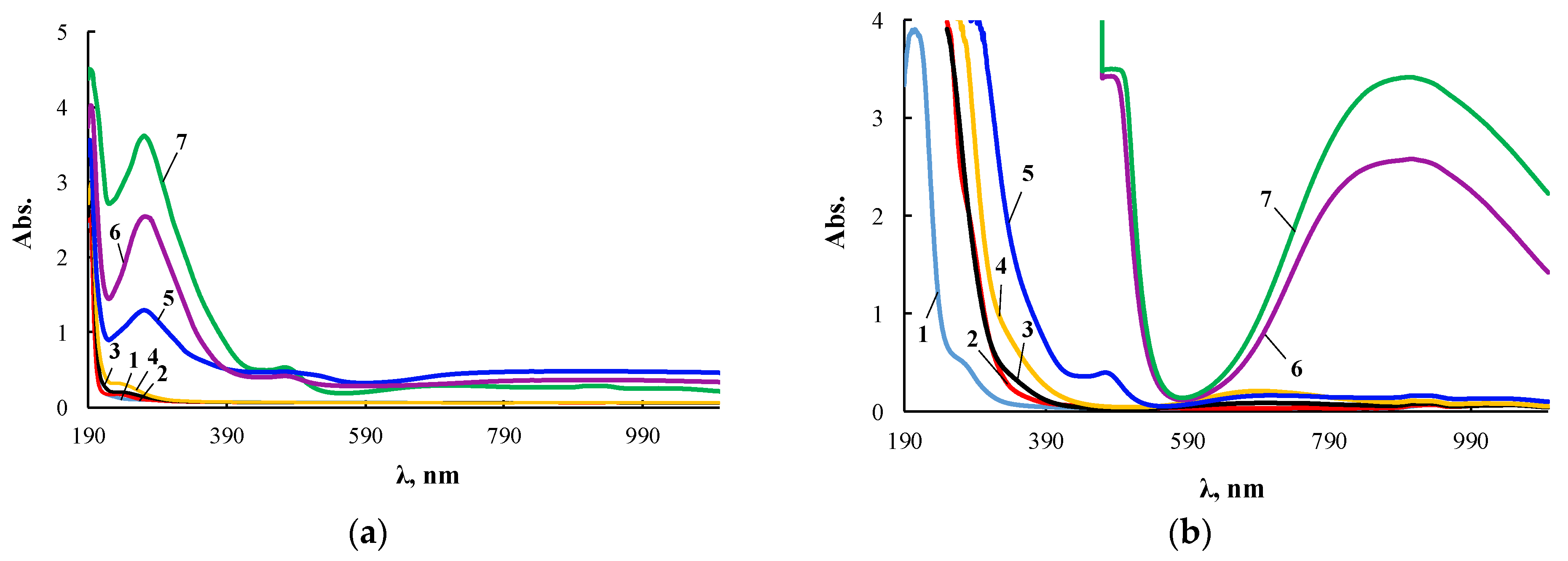




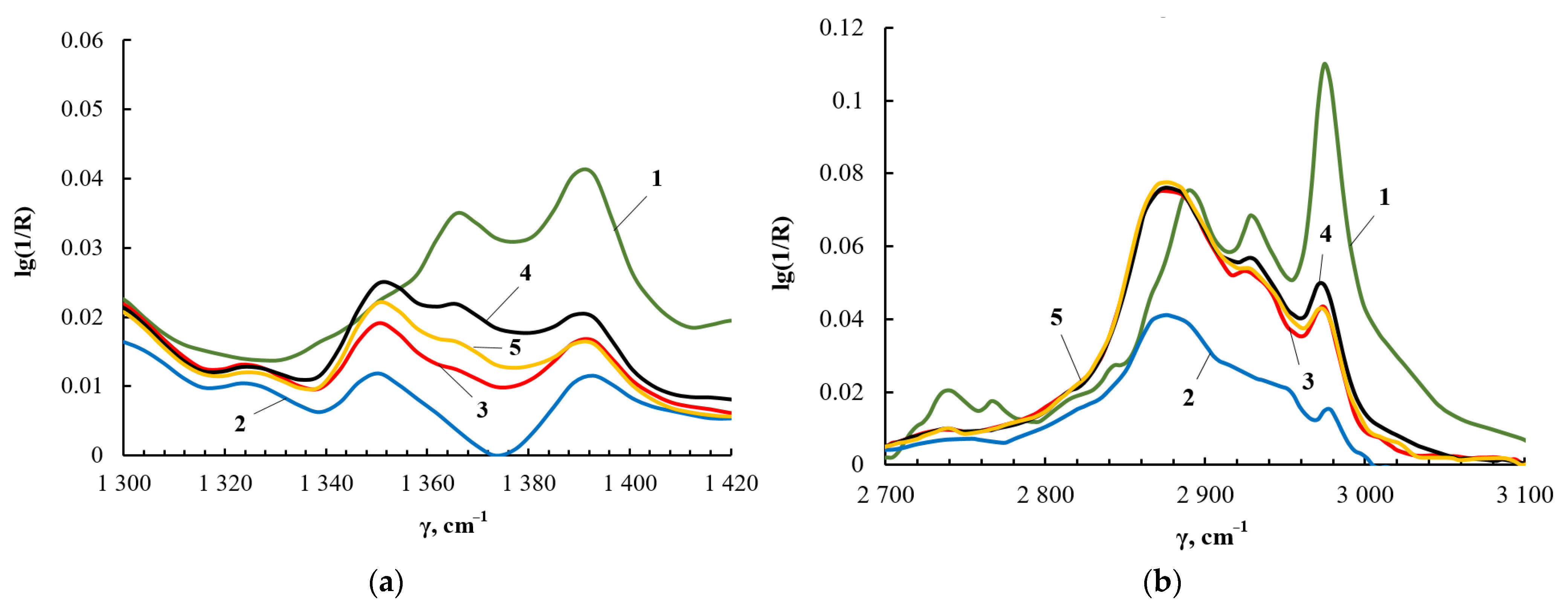
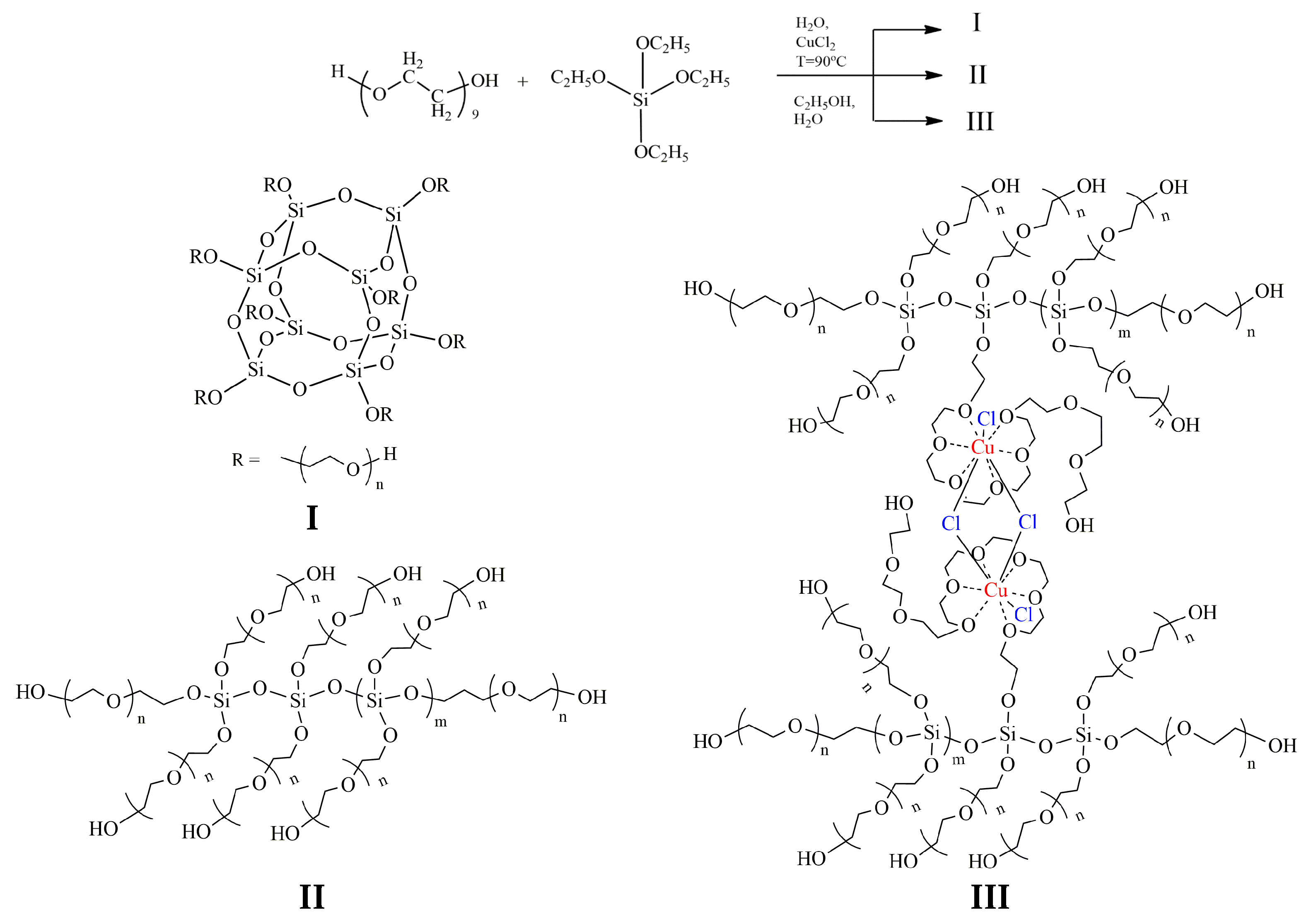

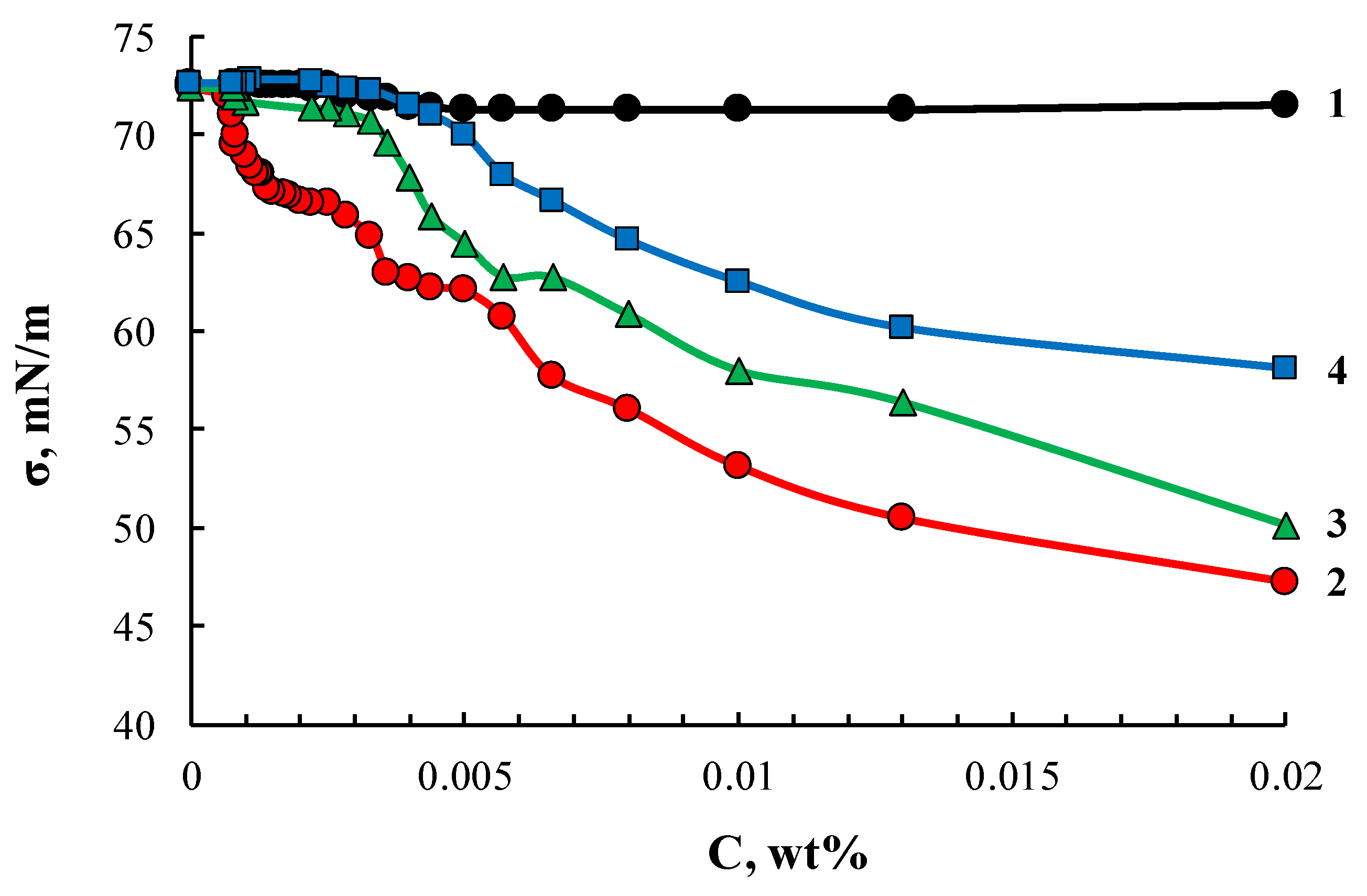

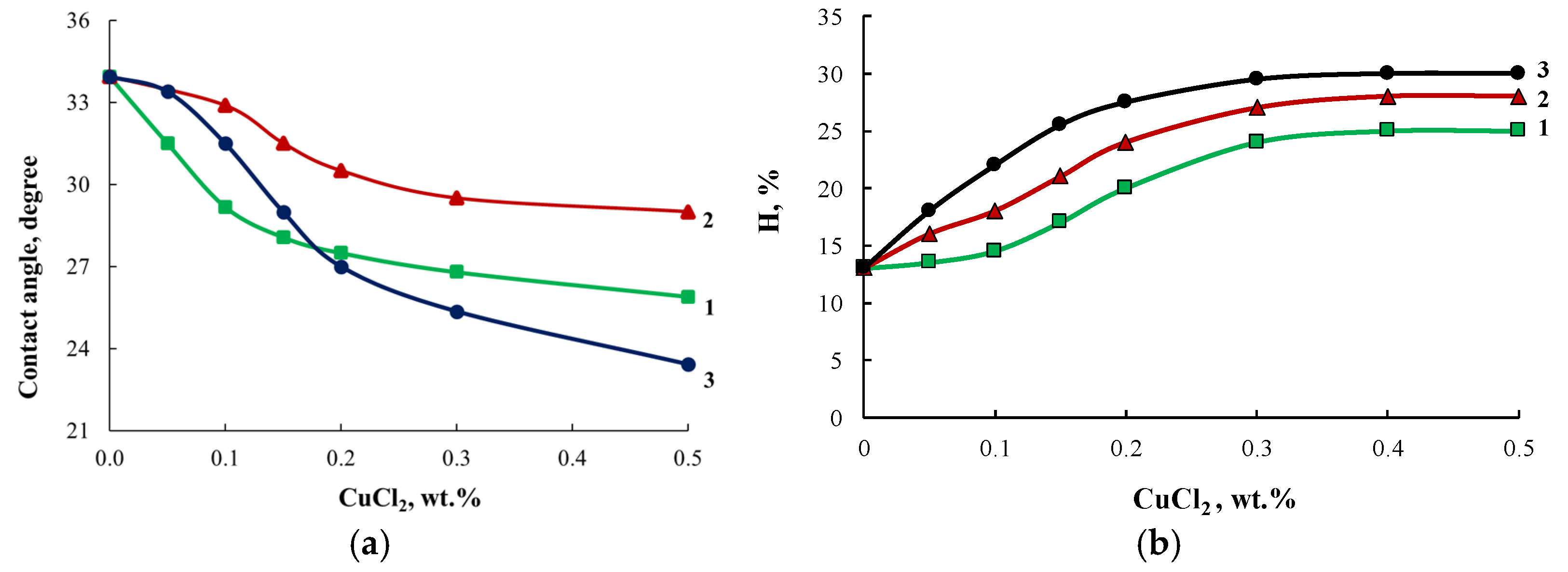

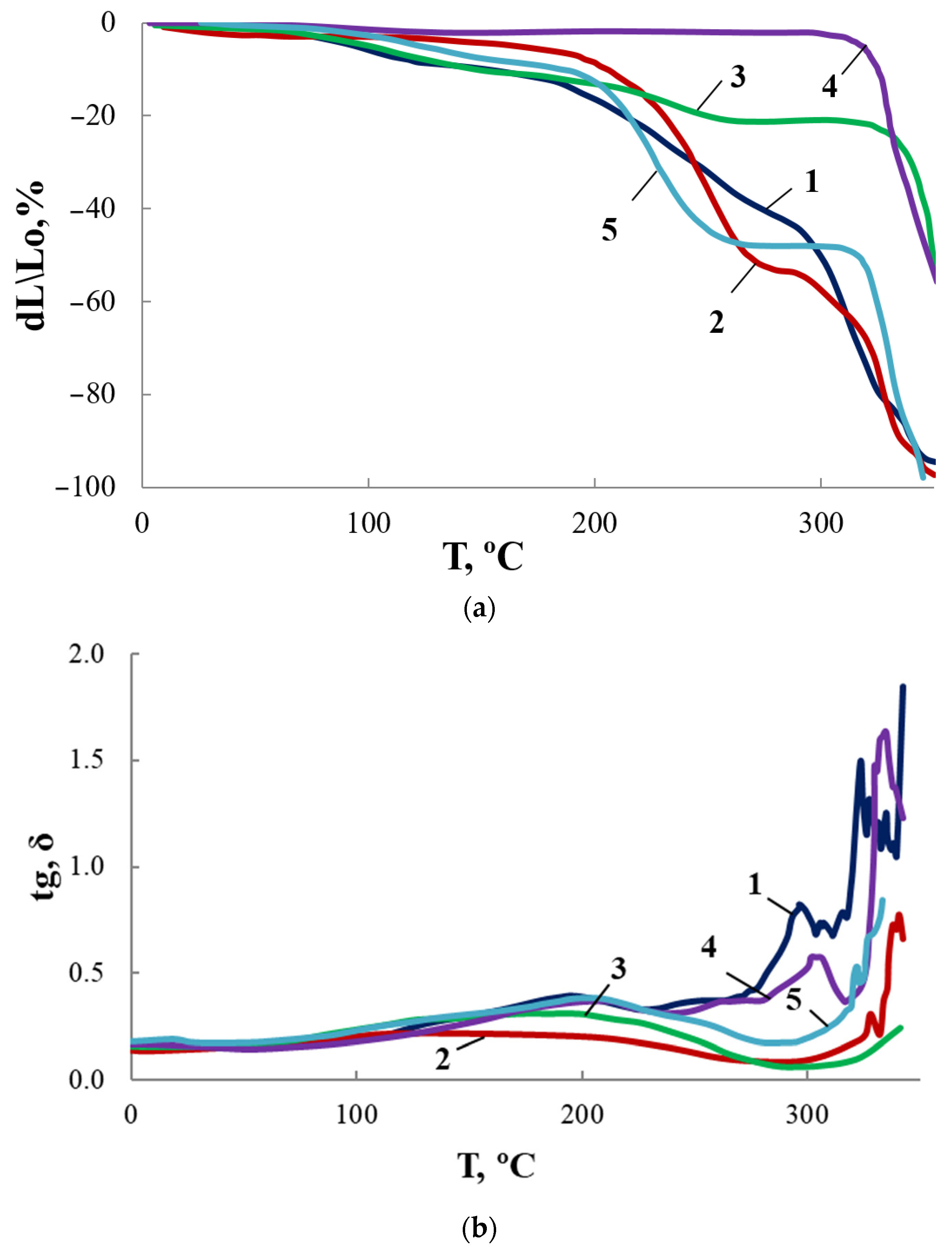
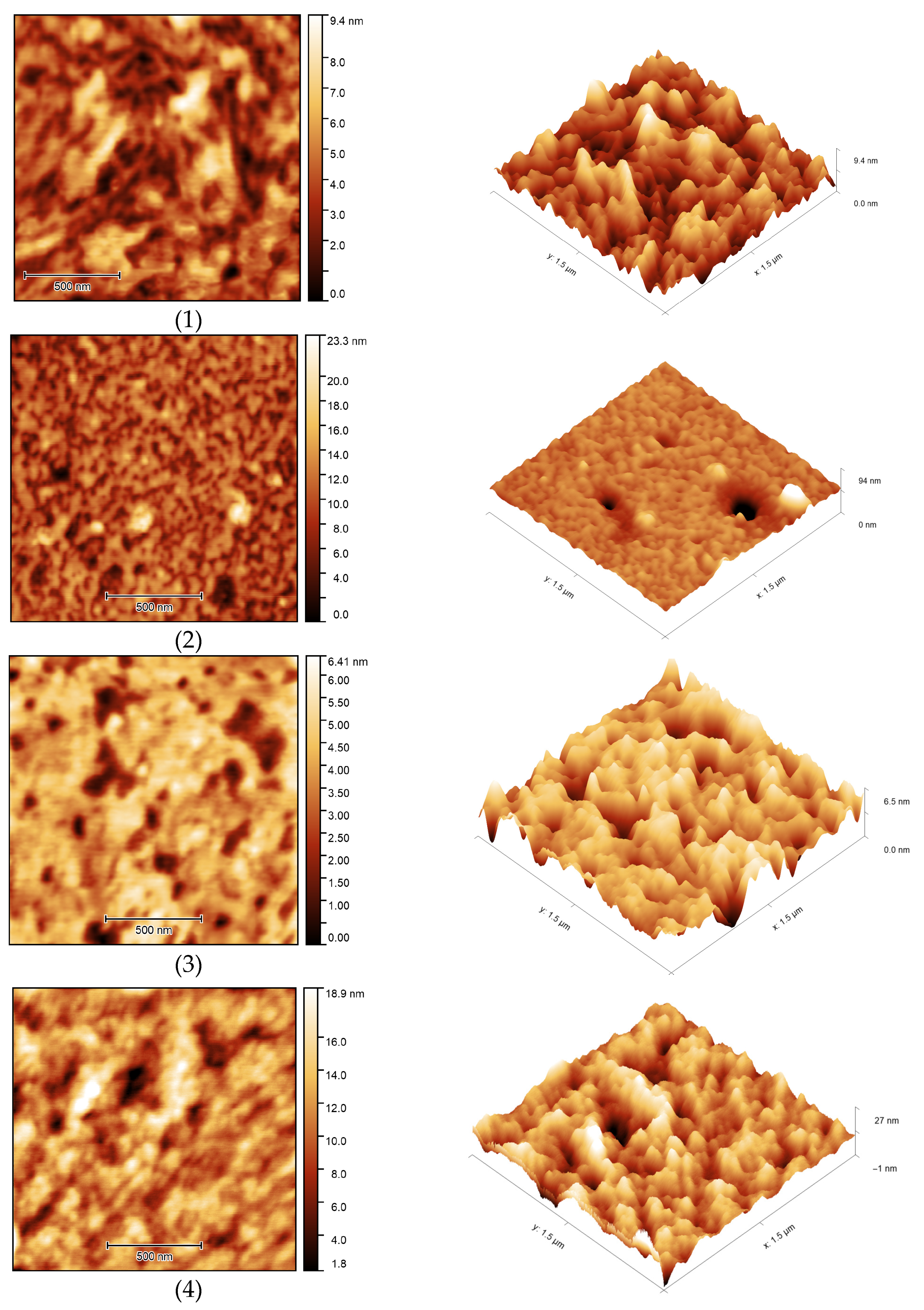

Disclaimer/Publisher’s Note: The statements, opinions and data contained in all publications are solely those of the individual author(s) and contributor(s) and not of MDPI and/or the editor(s). MDPI and/or the editor(s) disclaim responsibility for any injury to people or property resulting from any ideas, methods, instructions or products referred to in the content. |
© 2023 by the authors. Licensee MDPI, Basel, Switzerland. This article is an open access article distributed under the terms and conditions of the Creative Commons Attribution (CC BY) license (https://creativecommons.org/licenses/by/4.0/).
Share and Cite
Davletbaeva, I.M.; Faizulina, Z.Z.; Li, E.D.; Sazonov, O.O.; Efimov, S.V.; Klochkov, V.V.; Arkhipov, A.V.; Davletbaev, R.S. Silicas with Polyoxyethylene Branches for Modification of Membranes Based on Microporous Block Copolymers. Membranes 2023, 13, 642. https://doi.org/10.3390/membranes13070642
Davletbaeva IM, Faizulina ZZ, Li ED, Sazonov OO, Efimov SV, Klochkov VV, Arkhipov AV, Davletbaev RS. Silicas with Polyoxyethylene Branches for Modification of Membranes Based on Microporous Block Copolymers. Membranes. 2023; 13(7):642. https://doi.org/10.3390/membranes13070642
Chicago/Turabian StyleDavletbaeva, Ilsiya M., Zulfiya Z. Faizulina, Ekaterina D. Li, Oleg O. Sazonov, Sergey V. Efimov, Vladimir V. Klochkov, Alexander V. Arkhipov, and Ruslan S. Davletbaev. 2023. "Silicas with Polyoxyethylene Branches for Modification of Membranes Based on Microporous Block Copolymers" Membranes 13, no. 7: 642. https://doi.org/10.3390/membranes13070642
APA StyleDavletbaeva, I. M., Faizulina, Z. Z., Li, E. D., Sazonov, O. O., Efimov, S. V., Klochkov, V. V., Arkhipov, A. V., & Davletbaev, R. S. (2023). Silicas with Polyoxyethylene Branches for Modification of Membranes Based on Microporous Block Copolymers. Membranes, 13(7), 642. https://doi.org/10.3390/membranes13070642










